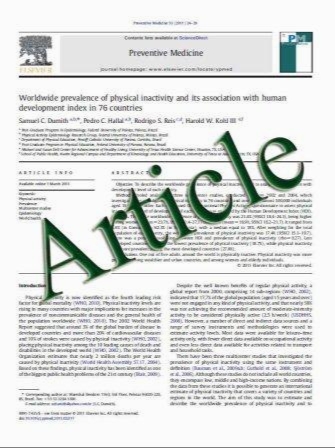Cardiac autonomic functions derived from short-term heart rate variability recordings associated with heart rate recovery after treadmill exercise test in young individuals
- نوع فایل : کتاب
- زبان : انگلیسی
- مؤلف : Ju-Yi Chen Yungling Leo Lee Wei-Chuan Tsai Cheng-Han Lee Po-Sheng Chen Yi-Heng Li Liang-Miin Tsai Jyh-Hong Chen Li-Jen Lin
- چاپ و سال / کشور: 2010
Description
Analysis of short-term heart rate variability (HRV) may provide useful information about autonomic nervous control of heart rate recovery. We studied 495 individuals (273 men), age range 19–85 years, submitted to treadmill exercise tests and short-term HRV evaluations over time (standard deviation of the normal-to-normal interval [SDNN], the square root of the mean squared differences of successive normal-to-normal intervals [RMSSD], the number of interval differences of successive normal-to-normal intervals greater than 50 ms [NN50 count], the proportion derived by dividing NN50 count by the total number of normal-to-normal intervals [pNN50]) and frequency (low-frequency power [LF], high-frequency power [HF], total power) domains. Among 495 patients, 106 patients (68 men) were elderly (age C 65 years). Male gender and hypertension were significantly higher in elderly patients. The young patients had higher HRR after exercise. HRR at 4 min (54 ± 13 vs 60 ± 12 beats/min; P = 0.003) was the most significant predictor for positive exercise test result. In the young group, both time domain measures (SDNN: correlation coefficient 0.34, P\0.001; RMSSD: correlation coefficient 0.37, P\0.001) and frequency domain measures (LF: correlation coefficient 0.21, P\0.001; HF: correlation coefficient 0.13, P = 0.01; total power: correlation coefficient 0.22, P\0.001) were significantly associated with HRR at 4 min. HRR at 4 min was significantly associated with short-term HRV of time and frequency domains in young individuals, but not elderly ones, receiving treadmill exercise test.
Heart Vessels (2011) 26:282–288 DOI 10.1007/s00380-010-0048-6 Received: 27 July 2009 / Accepted: 9 April 2010 / Published online: 30 October 2010


